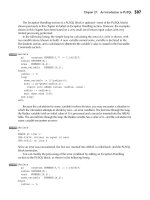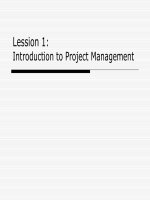section 01 introduction
Bạn đang xem bản rút gọn của tài liệu. Xem và tải ngay bản đầy đủ của tài liệu tại đây (1.08 MB, 46 trang )
Chemistry 5
The Art and Science of
Chemical Analysis
Introduction to Chemical
Analysis
• Chemical analysis includes any aspect of the chemical
characterization of a sample material.
• Analytical Chemistry?
– “Science of Chemical Measurements”
Areas of Chemical Analysis and
Questions They Answer
• Quantitation:
– How much of substance X is in the sample?
• Detection:
– Does the sample contain substance X?
• Identification:
– What is the identity of the substance in the sample?
• Separation:
– How can the species of interest be separated from the
sample matrix for better quantitation and
identification?
What do Chemical Analyst Do?
• Analyst:
• Applies known measurement techniques to well defined
compositional or characterization questions.
• Research Analytical Chemist
What do Chemical Analyst Do?
• Senior Analyst:
• Develops new measurement methods on existing
principles to solve new analysis problems.
What do Chemical Analyst Do?
• Research Analytical Chemist:
• Creates and /or investigates novel techniques or
principles for chemical measurements.
• or
• Conducts fundamental studies of chemical/physical
phenomena underlying chemical measurements.
What is Analytical Science?
• Analytical Chemistry provides the methods and
tools needed for insight into our material
world…for answering four basic questions
about a material sample?
• What?
• Where?
• How much?
• What arrangement, structure or form?
• Fresenius’ J. Anal. Chem. 343 (1992):812-813
Qualitative
Qualitativeanalysis
analysisisiswhat.
what.
Quantitative
Quantitativeanalysis
analysisisishow
howmuch.
much.
©Gary Christian, Analytical Chemistry,
6th Ed. (Wiley)
An
Ananalysis
analysisinvolves
involvesseveral
several
steps
stepsand
andoperations
operationswhich
which
depend
dependon:
on:
•the
•theparticular
particularproblem
problem
• •your
yourexpertise
expertise
• •the
theapparatus
apparatusor
or
equipment
available.
equipment available.
The
Theanalyst
analystshould
shouldbe
be
involved
in
every
step.
involved in every step.
©Gary Christian,
Analytical Chemistry,
6th Ed. (Wiley)
Fig. 1.1. Steps in an analysis
Different
Differentmethods
methodsprovide
provideaarange
rangeof
ofprecision,
precision,sensitivity,
sensitivity,selectivity,
selectivity,
and
speed
capabilities.
and speed capabilities.
©Gary Christian, Analytical Chemistry,
6th Ed. (Wiley)
The
Thesample
samplesize
sizedictates
dictateswhat
whatmeasurement
measurementtechniques
techniquescan
canbe
beused.
used.
©Gary Christian, Analytical Chemistry,
6th Ed. (Wiley)
Training of Chemical Analysts
(Analytical Chemists)
• Training focuses on principles and techniques for
solving measurement problems … but…
• Chemical analysts interface multiple disciplines to the
solution of chemical measurement problems
– Physical-, organic-, inorganic-, bio-chem-, physics,
math, biology, electronic, computers
Chemistry 5
Training Focuses on
• Underlying principles of chemical measurements
( integrating all chemistry fields, math, physics,
biology, electronics, and computers).
• Developing proficiency with quantitative analysis
laboratory procedures
• Exposure to role of chemical analysis in a broad range
of modern science.
Chemical Analysis Affects Many
Fields
• Physical-, Organic-, …, Chemistry:
– “Theory guides but Experiment decides”
• Biotechnology:
– Distinguishing isomers with differing bioactivities.
– Biosenors
• Materials Science:
– High-temperature superconductors
Chemical Analysis Affects Many
Fields
• Manufacturing:
– Quality control of packaged foods specifications
• Forensics:
– Chemical features for criminal evidence
Role of Analytical Chemistry in
Modern Science
• Case Study 1.
• Nuclear Waste
Disposal
–
–
–
–
Nuclear Power Plants
Nuclear Reactors
Weapons Processing
Weapons Disposal
Nuclear Waste Disposal Case Study
One Disposal Plan:
seal waste in corrosion-resistant containers
bury 1000’s of feet underground (rocky strata above
water table)
Must remain contained for> 20,000 years
Nuclear Waste Disposal Case Study
• Technical Problems:
• Metal Package Corrosion:
– M + water, oxygen, oxidizers M ions + products
To human
water supply
Underground
water
Nuclear Waste Disposal Case Study
• Repository above water table, but some water
present
• Model exists for chemical reactions, rates, and
time-dependent dispersion of products and
waste
• Predicted containment time depends on very
accurate measurements of microscopic
corrosion processes over short periods (weeks,
months)
Nuclear Waste Disposal Case Study
• Corrosion Model:
• M + H2O, SO42-, O2 M+ + OH- , H2
• CO3=, H+, F-, Cl-, MXn+
:
• NO2-, NO3-, S=,etc.MYm+, MZj + Prod.
Nuclear Waste Disposal Case Study
• What Do We Need To Know?
• Laboratory Simulation Studies
• Water Composition at site before container
placement.
• Water Composition after exposure to container
– Time dependence (rate of product growth over
weeks/months)
– Small changes must be measured very precisely









